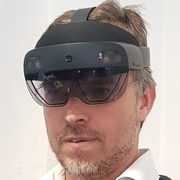XR-aided Design (XAD): Shaping the Future of CAD
A special issue of Applied Sciences (ISSN 2076-3417). This special issue belongs to the section "Computing and Artificial Intelligence".
Deadline for manuscript submissions: closed (10 March 2021) | Viewed by 7394
Special Issue Editors
Interests: virtual and augmented reality; computer aided design; 2D/3D interaction and user interface techniques, interactive design
Interests: geometry modelling; semantic shape processing; 2D/3D interaction and user interface techniques; knowledge management and information retrieval
Interests: mechanical and industrial design; QFD; TRIZ; CAD; VR &AR; additive manufacturing
Special Issues, Collections and Topics in MDPI journals
Interests: mixed reality; industrial applications; technical training; user studies
Special Issues, Collections and Topics in MDPI journals
Special Issue Information
Dear Colleagues,
Over the last few years, disciplines concerned with virtual, and augmented and mixed reality, computer-aided design, and human factors, have evolved profoundly due to ever-increasing computational power provided by the availability of new hardware and software technologies. Arbitrarily shaped non‐flat displays, portable augmented reality glasses, micro-projection units, portable marker-less gesture tracking systems, increasingly accurate biometric sensors, and brain-machine interfaces are becoming accessible as commodities. Furthermore, cross reality (XR), a specific type of mixed reality system wherein the user interacts with ubiquitous sensor and actuator networks, can fundamentally replace the way we artificially perceive and interact with data and CAD models.
Previously, these technologies were only available in well-funded research labs, but now they are entering the mainstream market, causing a revolutionary paradigm shift at the general public level. However, despite the quality of immersive environments improving dramatically over recent decades, XR implementations are not yet mature enough to fully replace physical mockups in the design stages of the product development cycle, first and foremost due to four major challenges: a) a lack of appropriate and efficient immersive interaction techniques for styling and designing in virtual spaces, b) poor implementations of haptics, c) a scarcity of integrated interactive simulations, and d) CAD systems not being optimized for enhancement of human capabilities, specifically regarding their inability to curate information according to users’ cognitive needs. Thus, the majority of use cases for XR are still impractical during the product development process – this work is still predominantly facilitated by keyboard-and-mouse CAD systems.
This call for papers aims to overcome these challenges by inciting research into CAD software development and interfaces combined with virtual, augmented, mixed, and cross reality interactive environments. The main focus of this special issue is on the detailed dissection of these technologies, their relationship to one another, and their unique abilities to realize theoretical XR capabilities and design principles in multimodal immersive environments. We appreciate contributions from both commercial and academic sources; from researchers as well as practitioners.
We invite submissions concerning, but not limited to, the following subjects:
- Immersive and collaborative design environment;
- Interactive 3D modelling;
- Generative design in immersive environments;
- Applications of artificial intelligence in CAD technology;
- Interface for CAD model manipulation;
- CAD systems leveraging Digital Twins;
- Interactive simulation;
- Mixed reality application in product development;
- AR/VR devices and technologies;
- Interactive and immersive geodesign;
- Usability evaluation;
- Cybersickness;
- P2V (physical to virtual) and V2P (virtual to physical) correspondences…
Prof. Raffaele de Amicis
Prof. Andre’ Strok
Prof. Alfredo Liverani
Prof. Michele Fiorentino
Prof. Giuseppe Di Gironimo
Guest Editors
Manuscript Submission Information
Manuscripts should be submitted online at www.mdpi.com by registering and logging in to this website. Once you are registered, click here to go to the submission form. Manuscripts can be submitted until the deadline. All submissions that pass pre-check are peer-reviewed. Accepted papers will be published continuously in the journal (as soon as accepted) and will be listed together on the special issue website. Research articles, review articles as well as short communications are invited. For planned papers, a title and short abstract (about 100 words) can be sent to the Editorial Office for announcement on this website.
Submitted manuscripts should not have been published previously, nor be under consideration for publication elsewhere (except conference proceedings papers). All manuscripts are thoroughly refereed through a single-blind peer-review process. A guide for authors and other relevant information for submission of manuscripts is available on the Instructions for Authors page. Applied Sciences is an international peer-reviewed open access semimonthly journal published by MDPI.
Please visit the Instructions for Authors page before submitting a manuscript. The Article Processing Charge (APC) for publication in this open access journal is 2400 CHF (Swiss Francs). Submitted papers should be well formatted and use good English. Authors may use MDPI's English editing service prior to publication or during author revisions.
Keywords
- Computer-aided engineering and design;
- Virtual, augmented, and mixed reality;
- Graphics and human computer interfaces;
- Interactive product development and realization;
- Interactive design;
- Visualisation techniques;
- Ergonomics;
- Geometry manipulation and optimization;
- HCI (human computer interaction);
- Simulation;
- Knowledge based engineering;
- human centered design…
Benefits of Publishing in a Special Issue
- Ease of navigation: Grouping papers by topic helps scholars navigate broad scope journals more efficiently.
- Greater discoverability: Special Issues support the reach and impact of scientific research. Articles in Special Issues are more discoverable and cited more frequently.
- Expansion of research network: Special Issues facilitate connections among authors, fostering scientific collaborations.
- External promotion: Articles in Special Issues are often promoted through the journal's social media, increasing their visibility.
- e-Book format: Special Issues with more than 10 articles can be published as dedicated e-books, ensuring wide and rapid dissemination.
Further information on MDPI's Special Issue polices can be found here.









